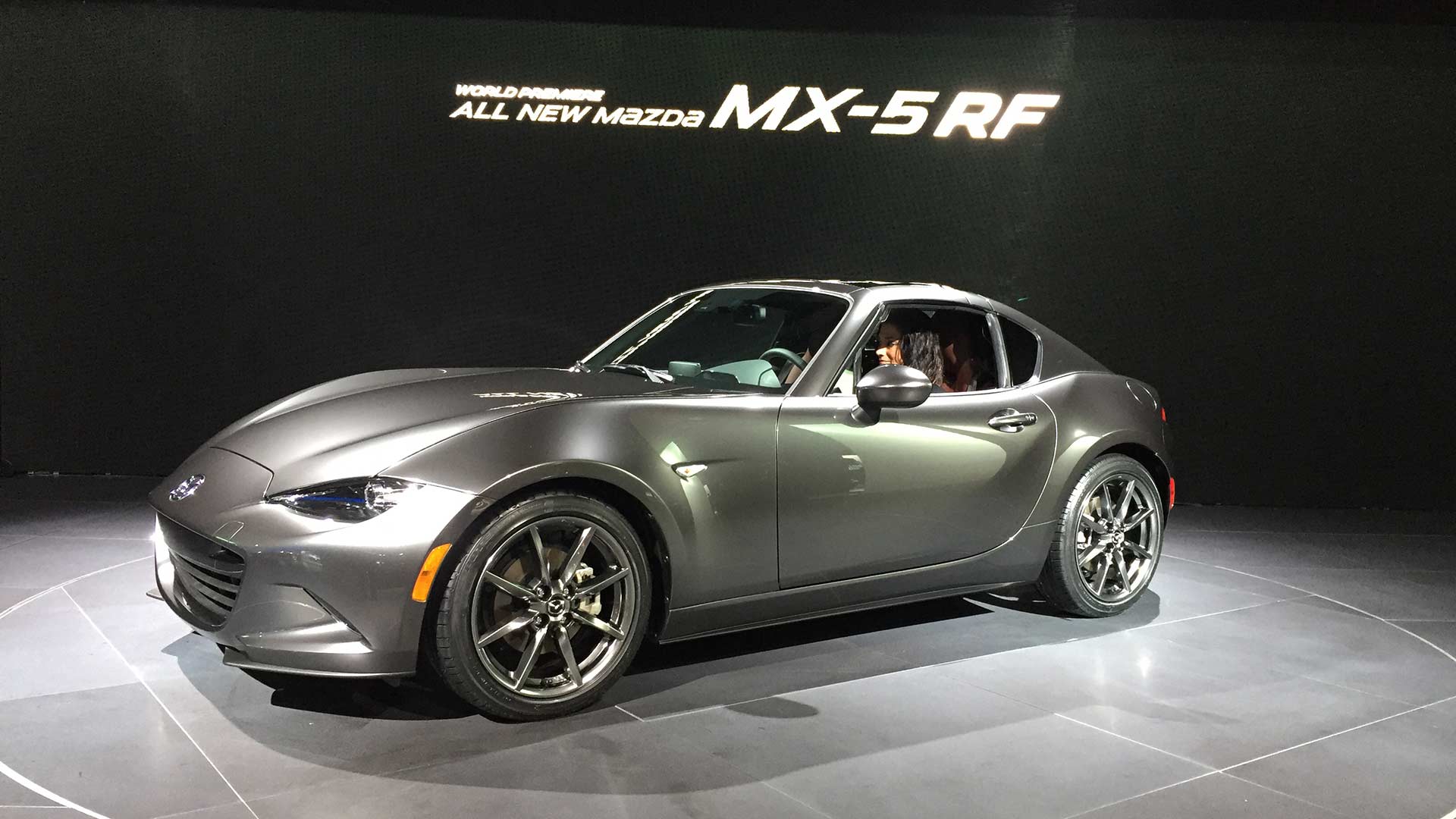

We may earn revenue from the products available on this page and participate in affiliate programs. Learn more ›
Cue the Vivaldi. But please, Mazda maestros, try and ditch the piano black: Steinway it’s not.
The four seasons, folding-hardtop version of the new Miata is here, though Mazda execs cautioned it’ll miss summer frolic and not reach America until January or so. Still, on the eve of the New York International Auto Show, Mazda popped the Miata’s new metal top at an event space in Chelsea, not far from Tesla’s Manhattan showroom. It’s called the MX-5 RF, for Retractable Fastback.
FF, for Faux Fastback, would’ve been as appropriate: The hardtop Mazda is striking, even if its fastback look is largely visual trompe l’oeil. Viewed from the side, the RF’s flying buttress roof and pseudo-three-quarter coupe windows suggest the teardrop, cab-rearward look of a classic two-plus-two (think: Jaguar). Top down, it’s more of a 911 Targa effect than the full retractable convertible of the previous generation MX-5; Mazda says the new car’s smaller dimensions wouldn’t allow it without seriously impinging on cargo space. Upside? The hard roof tucks into the same space as the canvas one, leaving a decent 6.2 cubic feet of trunk room, erect or stowed. The Miata also maintains the cloth top’s 50/50 front-rear weight distribution, so the extra flab—figure roughly 130 pounds—is the only performance handicap. Other mechanicals remain the same, including the 155-horsepower, 2.0-liter four-cylinder engine and choice of six speeds in manual or automatic gearbox variety.
Mazda spokesman Jeremy Barnes confirmed that the RF should cost roughly $1,500 to $1,800 more than the ragtop Mazda. That’ll put it right around $27,500 to start, or $35,000 fully loaded. (That’s including the hardtop’s upgraded Nappa leather upholstery.)

Where the previous hardtop almost seemed to disguise itself—as though a bit embarrassed over its sensible nature—the new one cranks up Metallica-style, especially the in-vogue roof buttresses that swoop like a pair of Flying V guitar bodies. The multi-part roof folds and swallows itself in a complex, 12-second ballet, at driving speeds up to 6.2 mph. An upright rear window bisects the buttresses and tucks away with the roof, with the option of raising a slimmer clear wind blocker from below.
The only visual distress involves piano black plastic, the smudgy, low-toned stuff that we can’t stand on an ashtray cover, let alone slathered across an entire roof section, the inner surfaces of the buttresses, and to suggest those faux darkened rear windows and a true fastback canopy. We worry that expanse of ebony may not play well in two-tone with certain exterior colors. The pseudo side glass recalls the fake portholes on old Buicks, and seems a finger in the eye of Mazda’s minimal, authentic design ethos.
Fortunately, Mazda designer Julian Montousse suggested that body colored roofs, at least, will be an option.

The Mazda has offered removable hardtops over its previous three generations. And the third-gen’s nifty power-folding hardtop proved so popular that it outsold the cloth top by the end of the car’s run. Overall, Mazda sold 35,000 Miata hardtops among 87,000 third-gen cars. That made a new hardtop virtually inevitable, despite the usual grousing from purists: Convertibles are at their lowest level of popularity in decades, so Mazda clearly needs any and every lure it can get.
Barnes says the hardtop typically draws a more urban, affluent crowd, attracted to “the perception of quiet and safety,” even if the prospect of thieves slashing a ragtop to gain entry was largely urban myth – what, you think a scumbag won’t break a side window before destroying an entire convertible top?
At this first exposure, we’ll stick with the Mazda’s classic, blissfully light and no-fuss softtop, thank you. But the hardtop expands the Miata’s appeal, even as it contracts the full convertible experience. The lack of real-or-perceived convertible drawbacks, Barnes says, is critical to get buyers to spring for what’s almost always a second or third household car.
“It’s a spare, not a daily driver,” Barnes says. “Most people just don’t drive two-seaters every day anymore.”


